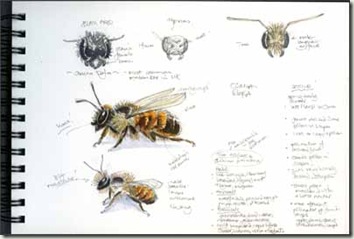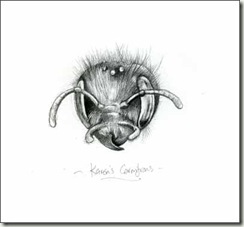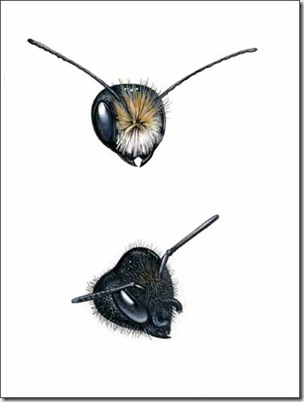While making some more notes on British bees, I was interested to read more about the funny little horned, female Osmia rufa.
The Osmia family in general are a really delightful bunch, not only hard working pollinators for your fruit trees but gentle too and ideal bees to keep in the garden.
I painted Osmia lignaria, the Blue Orchard bee for Deborah but that particular species is hornless.
The “horns” in question are two small protuberances which can be seen (if you get very up close and personal with the bee) just above the mandibles.
It seems they are used for shaping the mud which this clever little bee uses to build her nests, hence the common name “mason bee”.
The male O rufa on the other hand sports a fine white “moustache” and has longer more elegant antenna than the female.
I also remembered that I had a specimen of Osmia cornifrons which Karen Strickler at Pollinator Paradise had kindly sent me along with O lignaria.
This bee also has the curious horns on the female’s face. It’s not a native USA bee but was introduced from Japan in 1977 to help with orchard pollination. With the help of a magnifying lens I was able to make this drawing of the female cornifrons’ head complete with horns.
Osmia cornifrons face
She is much hairier than her rufa relation. Then a couple of studies of the Osmia rufa… cute male head at the top and female at the bottom. .
Osmia rufa faces, male and female
The female also has huge jaws which she uses to collect mud for the nest and presumably to make the nests too. I don’t have time to write more today but will return to these nice little bees very soon with more info and more drawings….









Well I never knew that was the Mason bee's Sunday name!
How come the males are always more colourful than the females? It always seems to be the same in nature (apart from the human species it seems!!)
Lovely pictures. Sorry to be nosey, but how long does it take to produce the two heads, foe example?
Best wishes
Dan
Hi Dan, yes it does seem that in nature the boys are often the colourful ones, they have try that bit harder. 🙂
The heads would take about 2 hours actual painting time, but that is after all the research and the prelim sketches. That's what takes most of the time. It took two days really trying to find out about what the horns were for and how they looked and where situated etc. but, having drawn them now I will be quicker next time.. if there is a next time!